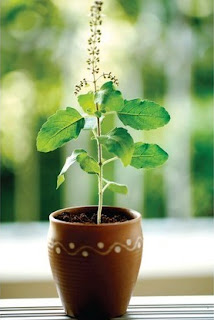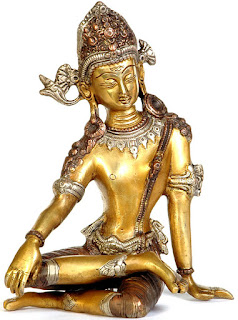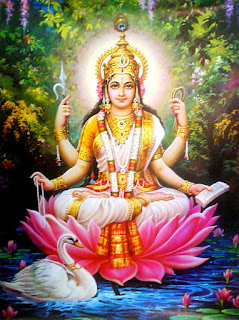The Tulsi is regarded as a sacred plant in Hinduism, and is an essential component in many rituals. The word, Tulsi literally means , “Incomparable” and true to its name, this plant is truly incomparable because of its medicinal uses. In the stories of Bhagavata and Mahabharata, Tulsi is said to be a devotee of Lord Vishunu, who took reincarnation in the form of a plant that would be offered to Lord Vishnu for his worship. In the Pardma Purana Lord Shiva describes the utilities of Tulsi to Narad.
In our holy scriptures tulsi is addressed by many names like Ajaka, Surasah, Manjari, Parnasa, Bhutagni and Haripriya.
The place around a tulsi plant is considered sacred. A person who is on his deathbed is given tulsi water to drink in order to cleanse his soul. The tulsi also purifies the air. It has been scientifically proved that the tulsi prevents mosquitoes from coming near it, thereby reducing the incidence of malaria. It also has great medicinal properties,and can tackle all types of fevers. The juice of tulsi leaves cures cough and cold.
The sages of yore asked us to nurture and take care of such a magical plant by asking us to worship it and advised us to equate it with the Almighty. Our forefathers were not worshippers of non-living things without any logic; behind each ritual there exists a reason.
Asking certain things to worship means, asking the people to honour and preserve them. Worship of tulsi was a trick by the sages to ask to preserve it. Consequently, people started taking care of this plant and planted it near their home. Hindu tradition teaches us to pay obedience and gratitude to something that is beneficial for us. And the worship of tulsi was just an expression of this gratitude.
BENEFITS OF TULSI:
The British, during their rule in India used to mock at the Indians for their beliefs on Tulsi. But when it was discovered by modern medical sciene that tulsi has anabolic, muscle relaxant, hypoglycemic, cardiac depressant, anti-allergic, adaptogenic antifertility and immunomodulator properties, people from all over the world started using tulsi in medicines and growing it.
Most of the facts of Hindu traditions are science. Only they are waiting to be discovered in the light of modern science. So, it will be unwise to ignore something as age-old traditions and many secrets of science are hidden in it.
FESTIVAL OF TULSI:
In Hindu mythology, Tulsi is regarded as the consort of Lord Vishnu. So, she is equalled to Goddess Lakshmi. Tulsi festival is celebrated each year. On this day, she is occassionaly married to Vishnu. This festival is celebrated on the eleventh day of Shukla Paksha in the month of Kartika. Fom this day, the the marriage season in India also starts. The days after this day are regarded as auspicious.
I Dr. Puneet Chawla promise to give lot of information for the prosperity in your life.
Contact :- 9899777806 / 9873333108
Email :- contact@livevaastu.com
In our holy scriptures tulsi is addressed by many names like Ajaka, Surasah, Manjari, Parnasa, Bhutagni and Haripriya.
The place around a tulsi plant is considered sacred. A person who is on his deathbed is given tulsi water to drink in order to cleanse his soul. The tulsi also purifies the air. It has been scientifically proved that the tulsi prevents mosquitoes from coming near it, thereby reducing the incidence of malaria. It also has great medicinal properties,and can tackle all types of fevers. The juice of tulsi leaves cures cough and cold.
The sages of yore asked us to nurture and take care of such a magical plant by asking us to worship it and advised us to equate it with the Almighty. Our forefathers were not worshippers of non-living things without any logic; behind each ritual there exists a reason.
Asking certain things to worship means, asking the people to honour and preserve them. Worship of tulsi was a trick by the sages to ask to preserve it. Consequently, people started taking care of this plant and planted it near their home. Hindu tradition teaches us to pay obedience and gratitude to something that is beneficial for us. And the worship of tulsi was just an expression of this gratitude.
BENEFITS OF TULSI:
- Tulsi enhances immunity and metabolic function.
- The anti cough properties of tulsi are well-known.
- It is also helpful in the respiratory problems
- Tulsi also has anti stress properties. It can reduce the level of stress in a human being.
- Tulsi also has anti diabetic properties. In the studies, it have been found that it can reduce the level of glocuse in blood.
- Tulsi is a de-toxicant. Its regular use can prevent heart attack.
The British, during their rule in India used to mock at the Indians for their beliefs on Tulsi. But when it was discovered by modern medical sciene that tulsi has anabolic, muscle relaxant, hypoglycemic, cardiac depressant, anti-allergic, adaptogenic antifertility and immunomodulator properties, people from all over the world started using tulsi in medicines and growing it.
Most of the facts of Hindu traditions are science. Only they are waiting to be discovered in the light of modern science. So, it will be unwise to ignore something as age-old traditions and many secrets of science are hidden in it.
FESTIVAL OF TULSI:
In Hindu mythology, Tulsi is regarded as the consort of Lord Vishnu. So, she is equalled to Goddess Lakshmi. Tulsi festival is celebrated each year. On this day, she is occassionaly married to Vishnu. This festival is celebrated on the eleventh day of Shukla Paksha in the month of Kartika. Fom this day, the the marriage season in India also starts. The days after this day are regarded as auspicious.
I Dr. Puneet Chawla promise to give lot of information for the prosperity in your life.
Contact :- 9899777806 / 9873333108
Email :- contact@livevaastu.com







